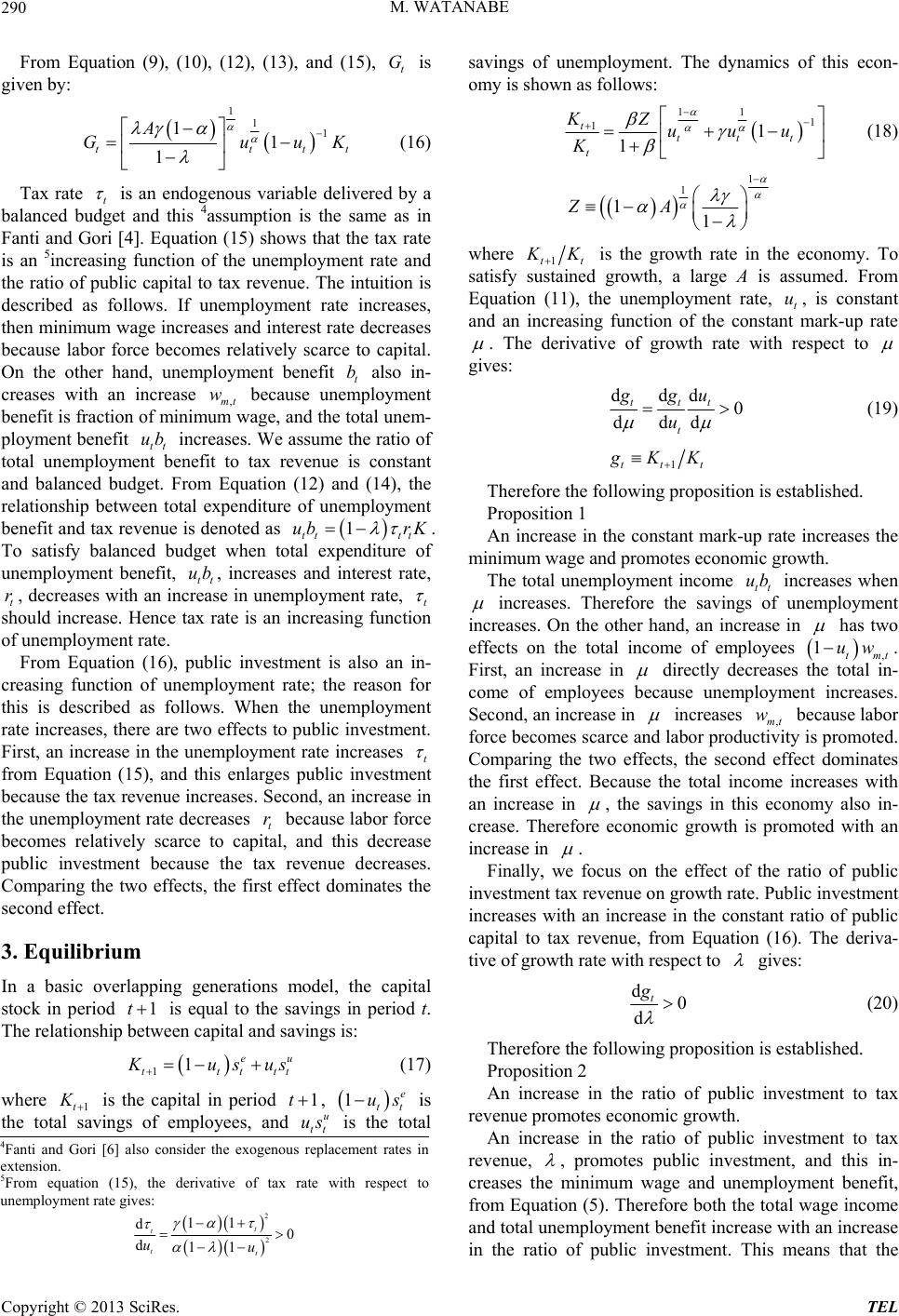
M. WATANABE
290
From Equation (9), (10), (12), (13), and (15), is
given by: t
G
111
11
1
tt
A
Gu
tt
uK
(16)
Tax rate t
is an endogenous variable delivered by a
balanced budget and this 4assumption is the same as in
Fanti and Gori [4]. Equation (15) shows that the tax rate
is an 5increasing function of the unemployment rate and
the ratio of public capital to tax revenue. The intuition is
described as follows. If unemployment rate increases,
then minimum wage increases and interest rate decreases
because labor force becomes relatively scarce to capital.
On the other hand, unemployment benefit t also in-
creases with an increase ,mt because unemployment
benefit is fraction of minimum wage, and the total unem-
ployment benefit tt
increases. We assume the ratio of
total unemployment benefit to tax revenue is constant
and balanced budget. From Equation (12) and (14), the
relationship between total expenditure of unemployment
benefit and tax revenue is denoted as tttt .
To satisfy balanced budget when total expenditure of
unemployment benefit, tt
, increases and interest rate,
t, decre ases with an incr ease in unemployment rate, t
b
1
w
ub
ub
ub rK
r
should increase. Hence tax rate is an increasing function
of unemployment rate.
From Equation (16), public investment is also an in-
creasing function of unemployment rate; the reason for
this is described as follows. When the unemployment
rate increases, there are two effects to public investment.
First, an increase in the unemployment rate increases t
from Equation (15), and this enlarges public investment
because the tax revenue increases. Second, an increase in
the unemployment rate decreases t because labor force
becomes relatively scarce to capital, and this decrease
public investment because the tax revenue decreases.
Comparing the two effects, the first effect dominates the
second effect.
r
3. Equilibrium
In a basic overlapping generations model, the capital
stock in period is equal to the savings in period t.
The relationship between ca pi tal and savi ngs is:
1t
11e
ttt
u
tt
us us
(17)
where 1t
is the capital in period , is
the total savings of employees, and is the total
savings of unemployment. The dynamics of this econ-
omy is shown as follows:
1tu
tt
us
1e
tt
us
11 1
11
1
tttt
t
KZuuu
K
(18)
1
1
11
ZA
where 1tt
K
is the growth rate in the economy. To
satisfy sustained growth, a large A is assumed. From
Equation (11), the unemployment rate, t, is constant
and an increasing function of the constant mark-up rate
u
. The derivative of growth rate with respect to
gives:
ddd0
ddd
ttt
t
ggu
u
(19)
1ttt
KK
Therefore the following proposition is established.
Proposition 1
An increase in the constant mark-up rate increases the
minimum wage and promotes economic growth.
The total unemployment income tt
increases when ub
increases. Therefore the savings of unemployment
increases. On the other hand, an increase in
has two
effects on the total income of employees tmt
.
First, an increase in
1
,
uw
directly decreases the total in-
come of employees because unemployment increases.
Second, an increase in
increases ,mt
wbecause labor
force becomes scarce and labor productivity is promoted.
Comparing the two effects, the second effect dominates
the first effect. Because the total income increases with
an increase in
, the savings this economy also in-
crease. Therefore economic growth is promoted with an
increase in
in
.
Finally, we focus on the effect of the ratio of public
investment tax revenue on growth rate. Public investment
increases with an increase in the constant ratio of public
capital to tax revenue, from Equation (16). The deriva-
tive of growth rate with respect to
gives:
d0
dt
g
(20)
Therefore the following proposition is established.
Proposition 2
An increase in the ratio of public investment to tax
revenue promotes economic growth.
An increase in the ratio of public investment to tax
revenue,
, promotes public investment, and this in-
creases the minimum wage and unemployment benefit,
from Equation (5). Therefore both the total wage income
and total unemployment benefit increase with an increase
in the ratio of public investment. This means that the
4Fanti and Gori [6] also consider the exogenous replacement rates in
extension.
5From equation (15), the derivative of tax rate with respect to
unemployment rate gives:
2
2
11
d0
d11
t
t
tt
uu
Copyright © 2013 SciRes. TEL